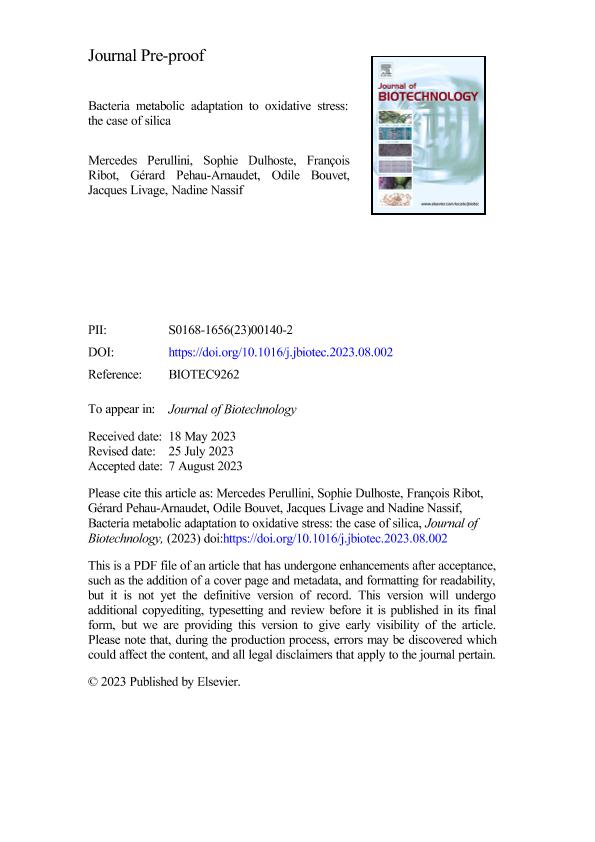Mostrar el registro sencillo del ítem
dc.contributor.author
Perullini, Ana Mercedes

dc.contributor.author
Dulhoste Vivien, Sophie

dc.contributor.author
Ribot, François
dc.contributor.author
Pehau-Arnaudet, Gérard
dc.contributor.author
Bouvet, Odile
dc.contributor.author
Livage, Jacques
dc.contributor.author
Nassif, Nadine
dc.date.available
2024-02-28T12:25:52Z
dc.date.issued
2023-09
dc.identifier.citation
Perullini, Ana Mercedes; Dulhoste Vivien, Sophie; Ribot, François; Pehau-Arnaudet, Gérard; Bouvet, Odile; et al.; Bacteria metabolic adaptation to oxidative stress: the case of silica; Elsevier Science; Journal of Biotechnology; 374; 9-2023; 80-89
dc.identifier.issn
0168-1656
dc.identifier.uri
http://hdl.handle.net/11336/228751
dc.description.abstract
Although the presence of silica in many living organisms offers advanced properties including cell protection, the different in vitro attempts to build living materials in pure silica never favoured the cells viability. Thus, little attention has been paid to host-guest interactions to modify the expected biologic response. Here we report the physiological changes undergone by Escherichia coli K-12 in silica from colloidal solution to gel confinement. We show that the physiological alterations in growing cultures are not triggered by the initial oxidative Reactive Oxygen Species (ROS) response. Silica promotes the induction of alternative metabolic pathways along with an increase of growth suggesting the existence of rpoS polymorphisms. Since the functionality of hybrid materials depends on the specific biologic responses of their guests, such cell physiological adaptation opens perspectives in the design of bioactive devices attracting for a large field of sciences.
dc.format
application/pdf
dc.language.iso
eng
dc.publisher
Elsevier Science

dc.rights
info:eu-repo/semantics/openAccess
dc.rights.uri
https://creativecommons.org/licenses/by-nc-sa/2.5/ar/
dc.subject
CONFINEMENT
dc.subject
LIVING MATERIALS
dc.subject
OXIDATIVE STRESS
dc.subject
PHYSIOLOGICAL ADAPTATION
dc.subject
RPOS POLYMORPHISMS
dc.subject
SILICA NANOPARTICLES
dc.subject.classification
Otras Nanotecnología

dc.subject.classification
Nanotecnología

dc.subject.classification
INGENIERÍAS Y TECNOLOGÍAS

dc.title
Bacteria metabolic adaptation to oxidative stress: the case of silica
dc.type
info:eu-repo/semantics/article
dc.type
info:ar-repo/semantics/artículo
dc.type
info:eu-repo/semantics/publishedVersion
dc.date.updated
2024-02-26T11:03:02Z
dc.journal.volume
374
dc.journal.pagination
80-89
dc.journal.pais
Países Bajos

dc.journal.ciudad
Amsterdam
dc.description.fil
Fil: Perullini, Ana Mercedes. Consejo Nacional de Investigaciones Científicas y Técnicas. Oficina de Coordinación Administrativa Ciudad Universitaria. Instituto de Química, Física de los Materiales, Medioambiente y Energía. Universidad de Buenos Aires. Facultad de Ciencias Exactas y Naturales. Instituto de Química, Física de los Materiales, Medioambiente y Energía; Argentina
dc.description.fil
Fil: Dulhoste Vivien, Sophie. Consejo Nacional de Investigaciones Científicas y Técnicas. Oficina de Coordinación Administrativa Ciudad Universitaria. Instituto de Química, Física de los Materiales, Medioambiente y Energía. Universidad de Buenos Aires. Facultad de Ciencias Exactas y Naturales. Instituto de Química, Física de los Materiales, Medioambiente y Energía; Argentina
dc.description.fil
Fil: Ribot, François. Sorbonne University; Francia
dc.description.fil
Fil: Pehau-Arnaudet, Gérard. Instituto Pasteur; Francia
dc.description.fil
Fil: Bouvet, Odile. Université Paris Diderot - Paris 7; Francia
dc.description.fil
Fil: Livage, Jacques. Sorbonne University; Francia
dc.description.fil
Fil: Nassif, Nadine. Sorbonne University; Francia
dc.journal.title
Journal of Biotechnology

dc.relation.alternativeid
info:eu-repo/semantics/altIdentifier/url/https://linkinghub.elsevier.com/retrieve/pii/S0168165623001402
dc.relation.alternativeid
info:eu-repo/semantics/altIdentifier/doi/http://dx.doi.org/10.1016/j.jbiotec.2023.08.002
Archivos asociados
